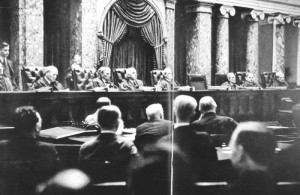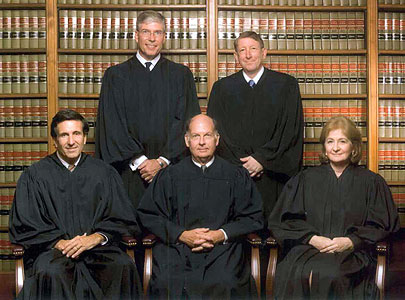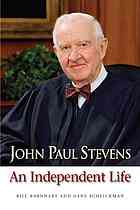Follow the latest US Supreme Court cases on your iPhone or other mobile device with OyezToday. OyezToday has easy-to-grasp abstracts for every case granted review, timely and searchable audio of oral arguments + transcripts, and up-to-date summaries of the Court’s most recent decisions including the Court’s full opinions.
The app was created by IIT Chicago-Kent College of Law and is available for both iPhone, iPad and Android devices FREE.
The most recent issue of The Scribes Journal of Legal Writing includes interviews with eight Supreme Court justices on legal writing. Bryan Garner, editor of Black’s Law Dictionary, interviews Justices Roberts, Stevens, Scalia, Kennedy, Thomas, Ginsburg, Breyer and Alito talk about the importance of legal writing, their literary influences, brief writing, academic writing and more.
Read the interviews.
More from NPR
 The United States Supreme Court does not allow photography during its sessions. Only two known photographers have been able to take photographs of the Court in session. Both did it by hiding their cameras.
The United States Supreme Court does not allow photography during its sessions. Only two known photographers have been able to take photographs of the Court in session. Both did it by hiding their cameras.
The most famous of these photos was taken by Erich Salomon. In 1932 Fortune magazine hired Salomon, a German photographer, to make a photographic tour of America. To get a photo of the Supreme Court he faked a broken arm and hid the camera in his sling.
Salomon had an interesting career as a photographer. He was a law student, receiving his law degree in 1913. He served in the German army in WWI, was captured and spent four years in a French POW camp. He tried a number of careers before he became a photographer, including running a car and motorcycle hire business where he offered to drive customers around on a motorcycle and give them legal advice at the same time. He eventually went to work for the Berliner Illustrirte Zeitung, a German newspaper, where he started his photography career by hiding a camera in his hat to take photos of a murder trial.
He eventually became famous for his photos of international conferences, specializing in capturing the rich and powerful in unguarded moments, often by hiding his camera or himself. Politicians joked that international conferences couldn’t start until Salomon arrived with his camera.
When the Nazis came to power, Salomon left Germany for the Netherlands, but when the Germans invaded the Netherlands he and his family were sent to Auschwitz, where he was killed in 1944.
For more information on Erich Salomon see:
http://iconicphotos.wordpress.com/2009/06/13/supreme-court-in-session/
http://www.comesana.com/english/salomon.php
http://www.e-flux.com/shows/view/6100
 On Wednesday April 20th the Delaware Supreme Court will hear oral arguments in 3 cases at Widener. The briefs for each case are available on Westlaw. Why not read them in advance so you’ll have a better understanding of the cases? Links to each brief are below.
On Wednesday April 20th the Delaware Supreme Court will hear oral arguments in 3 cases at Widener. The briefs for each case are available on Westlaw. Why not read them in advance so you’ll have a better understanding of the cases? Links to each brief are below.
10:00 AM – Docket no. 644, 2010 Reddy v. PMA Insurance
Attorneys: – Gilbert Shelsby – David A. Denham, Widener Law ’02
2011 WL 597854 (Del.Supr.) (Appellate Brief-Reply Brief of Defendant-Appellant, Santosh Reddy, M.D.) February 12, 2011.
2011 WL 439128 (Del.Supr.) (Appellate Brief-Answering Brief of Plaintiffs-Appellees, The PMA Insurance Company and CNA Insurance Company a/s/o Harbor Health Care & Rehabilitation Center, Inc.) January 27, 2011.
11:00 AM – Docket no. 711, 2010 Anderson v. State
Santino Ceccotti, Widener Law ’06 – Elizabeth McFarlan, Widener Law ’98
2011 WL 597856 (Del.Supr.) (Appellate Brief-Appellant’s Reply Brief) February 14, 2011.
2011 WL 439131 (Del.Supr.) (Appellate Brief-State of Delaware’s Answering Brief) January 27, 2011.
Noon – Docket no. 573, 2010 Phlipot v. State
Bernard J. O’Donnell – Abby L. Adams, Widener Law ’97
2011 WL 80292 (Del.Supr.) (Appellate Brief-Appellant’s Opening Brief) January 3, 2011.
2011 WL 512363 (Del.Supr.) (Appellate Brief-State’s Answering Brief) February 7, 2011.
 Bill Barnhart, Eugene F Schlickman. John Paul Stevens: An Independent Life. DeKalb, Ill.,: Northern Illinois University Press, 2010. KF8745.S78 B37 2010.
Bill Barnhart, Eugene F Schlickman. John Paul Stevens: An Independent Life. DeKalb, Ill.,: Northern Illinois University Press, 2010. KF8745.S78 B37 2010.
From the publisher: During Justice Sonya Sotomayor’s recent confirmation hearings, the idea of “biography” played a high-profile role in the debate. How much does a person’s experience affect his or her judicial opinions? Should personal history be a key consideration when determining qualifications to sit on the highest court in the land? In this impeccably researched book, journalist Bill Barnhart and retired lawyer and former legislator Gene Schlickman paint a detailed portrait of Justice John Paul Stevens’s remarkable life and tenure on the Court. Through vivid family history and a careful look at his work on the bench, Barnhart and Schlickman offer the first biography of the second longest serving Supreme Court justice of the modern era—one who has proudly earned the title of the Court’s most prolific dissenter.
To provide a nuanced and multifaceted look at the justice, Barnhart and Schlickman interviewed Stevens and an extraordinary number of Stevens’s friends and family members, former clerks, current colleagues, politicians, and court watchers. They spoke with such public figures as former President Ford, former Ford chief of staff Donald Rumsfeld, and Justice Ruth Bader Ginsburg. Interviews with Stevens’s children and one of his brothers provide personal insights into the man behind the robe. Tales of his childhood, of growing up in an affluent family in Chicago’s Hyde Park neighborhood, and of the family business, including The Stevens Hotel (now the Chicago Hilton and Towers), create a rich portrait of the independent man and judge. Intimate anecdotes from Stevens’s former law clerks reveal the lighter side of some of the most serious work in the country.
Barnhart and Schlickman also give careful consideration to Stevens’s career. They trace his early years as a Chicago lawyer, his appointment to the federal appeals bench in Chicago, and his ultimate nomination to the Supreme Court by Republican President Ford. They examine his best-known opinions, including his emotional dissents in Texas v. Johnson and Bush v. Gore. They trace his growth as a molder of Court decisions. In an era of an increasingly politicized judiciary, the story of Stevens’s life, as a lawyer who joined the bench with no political or ideological baggage, is an urgent reminder of the importance of judicial impartiality and the need to cultivate it. This vibrant biography will be of interest to those fascinated by the inner workings of the Supreme Court as well as those who simply want to learn more about one of Chicago’s favorite sons.
 Seth Stern, Stephen Wermiel. Justice Brennan: Liberal Champion. Boston, Houghton Mifflin Harcourt, 2010. KF8745 .B68 S74 2010
Seth Stern, Stephen Wermiel. Justice Brennan: Liberal Champion. Boston, Houghton Mifflin Harcourt, 2010. KF8745 .B68 S74 2010
From the publisher: This book is a sweeping and revealing insider look at court history and the life of William J. Brennan Jr., widely considered the most influential Supreme Court justice of the twentieth century. First appointed by President Dwight D. Eisenhower in 1956, Brennan became the Supreme Court’s leading liberal during his 34 terms as a justice.
Before his death, Brennan granted coauthor Stephen Wermiel access to a trove of personal and court materials that will not be available to the public until 2017. Wermiel also conducted more than 60 hours of interviews with Brennan over the course of six years. No other biographer has enjoyed this kind of access to a Supreme Court justice or to his papers.
Justice Brennan makes public for the first time the full contents of Brennan’s case histories, in which he recorded the strategizing behind all the major battles of the past half century, including Roe v. Wade, affirmative action, the death penalty, obscenity law, and the constitutional right to privacy.
Revelations on a more intimate scale include how Brennan refused to hire female clerks even as he wrote groundbreaking women’s rights decisions; his complex stance as a justice and a Catholic; and new details on Brennan’s unprecedented working relationship with Chief Justice Earl Warren. This riveting information—intensely valuable to readers of all political persuasions—will cement Brennan’s reputation as epic playmaker of the Court’s most liberal era.


 Bill Barnhart, Eugene F Schlickman. John Paul Stevens: An Independent Life. DeKalb, Ill.,: Northern Illinois University Press, 2010.
Bill Barnhart, Eugene F Schlickman. John Paul Stevens: An Independent Life. DeKalb, Ill.,: Northern Illinois University Press, 2010.  Seth Stern, Stephen Wermiel. Justice Brennan: Liberal Champion. Boston, Houghton Mifflin Harcourt, 2010.
Seth Stern, Stephen Wermiel. Justice Brennan: Liberal Champion. Boston, Houghton Mifflin Harcourt, 2010.